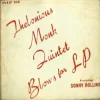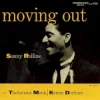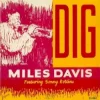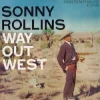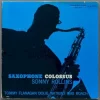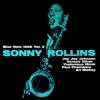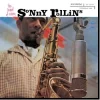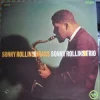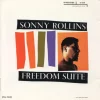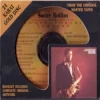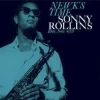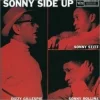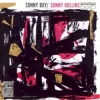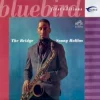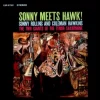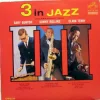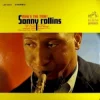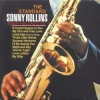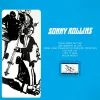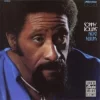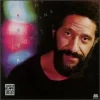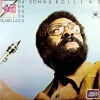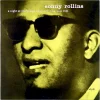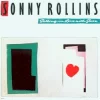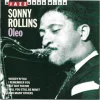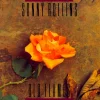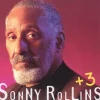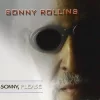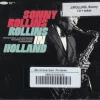Biography Sonny Rollins
Sonny Rollins (Theodore Walter Rollins, New York City, September 7, 1930) is an American jazz tenor saxophonist.
Rollins' long, prolific career began at the age of 11, and he was playing with piano legend Thelonious Monk before reaching the age of 20. Rollins is still touring and recording today, having outlived most of his contemporaries such as John Coltrane, Miles Davis, Max Roach, and Art Blakey, all performers with whom he recorded.
While Rollins was born in New York City, his parents were born in the United States Virgin Islands. Rollins received his first saxophone at age 13.
Rollins started as a pianist, changed to alto saxophone, and finally switched to tenor in 1946. During his high-school years, he played in a band with other future jazz legends Jackie McLean and Kenny Drew. He was first recorded in 1949 with Babs Gonzales – in the same year he recorded with J. J. Johnson and Bud Powell. In his recordings through 1954, he played with performers such as Miles Davis, Charlie Parker and Thelonious Monk.
In 1950, Rollins was arrested for armed robbery and given a sentence of three years. He spent 10 months in Rikers Island jail before he was released on parole. In 1952 he was arrested for violating the terms of his parole by using heroin. Rollins was assigned to what was then the only assistance in the U.S. for drug addicts: "Narco", "The Farm", aka Federal Medical Center, Lexington. While there he was a volunteer for then-experimental Methadone therapy and was able to "kick" – endure an opiate withdrawal. Rollins himself initially feared sobriety would impair his musicianship, but then went on to greater success.
As a saxophonist he had initially been attracted to the jump and R&B sounds of performers like Louis Jordan, but soon became drawn into the mainstream tenor saxophone tradition. Joachim Berendt has described this tradition as sitting between the two poles of the strong sonority of Coleman Hawkins and the light flexible phrasing of Lester Young, which did so much to inspire the fleet improvisation of be-bop in the 1950s.[6] Rollins drew the two threads together as a fluid post-bop improviser with a sound as strong and resonant as any since Hawkins himself.
Miles, Monk and the Clifford Brown/Max Roach Quintet
Rollins began to make a name for himself as he recorded with the Modern Jazz Quartet and with Miles Davis in 1951, recording his composition Oleo among others. In 1953 and 1954 he worked with Thelonious Monk, recording Thelonius Monk and Sonny Rollins, which includes "I Want to Be Happy" and "Friday the 13th". Rollins then joined the Clifford Brown–Max Roach quintet in 1955 (recordings made by this group have been released as Sonny Rollins Plus 4 and Clifford Brown and Max Roach at Basin Street; Rollins also plays on half of More Study in Brown), and after Brown's death in 1956 worked mainly as a leader. By this time he had begun his career with Prestige Records, which released many of his best-known albums, although at the height of his career in the 1950s Rollins was also recording regularly for Blue Note, Riverside and the Los Angeles label Contemporary.
Saxophone Colossus
His widely acclaimed album, Saxophone Colossus, was recorded on June 22, 1956 at Rudy Van Gelder's studio in New Jersey, with Tommy Flanagan on piano, former Jazz Messengers bassist Doug Watkins and his favorite drummer Max Roach. This was Rollins' third recording as a leader and it included his best-known composition "St. Thomas", a Caribbean calypso based on a tune sung to him by his mother in his childhood, as well as the fast bebop number "Strode Rode", and "Moritat" (the Kurt Weill composition also known as "Mack the Knife").
In 1956 he also recorded Tenor Madness, using Miles Davis' group – pianist Red Garland, bassist Paul Chambers, and drummer Philly Joe Jones. The title track is the only recording of Rollins with John Coltrane, who was also in Davis' group.
At the end of the year Rollins recorded a set for Blue Note with Donald Byrd on trumpet, Wynton Kelly on piano, Gene Ramey on bass, and Rollins' long-term collaborator Max Roach on drums. This has been released as Sonny Rollins Volume One (the superstar session Volume Two recorded the following year has consistently outsold it).
The piano-less trio
In 1957 he pioneered the use of bass and drums (without piano) as accompaniment for his saxophone solos. This texture came to be known as "strolling". Two early tenor/bass/drums trio recordings are Way Out West (Contemporary, 1957) and A Night at the Village Vanguard (Blue Note, 1957). Throughout his career, Rollins used the technique, even backing bass and drum solos with sax licks. Way Out West was so named because it included songs such as "Wagon Wheels" and "I'm an Old Cowhand" and was recorded for a Californian label with Los Angeles based drummer Shelly Manne. The Village Vanguard CD consists of two sets, a matinee with bassist Donald Bailey and drummer Pete LaRoca and then the evening set with Wilbur Ware and Elvin Jones.
By this time, Rollins had become well-known for taking relatively banal or unconventional material (such as "There's No Business Like Show Business" on Work Time, "I'm an Old Cowhand", and later "Sweet Leilani" on the Grammy-winning CD This Is What I Do) and turning it into a vehicle for improvisation. He also is quite well-known as a composer; a number of his tunes (including "St. Thomas", "Doxy", "Oleo" and "Airegin") have become standards.
1957's Newk's Time saw him working with a piano again, in this case Wynton Kelly but one of the most highly regarded tracks is a saxophone/drum duet (Surrey with the Fringe on Top with Philly Joe Jones). Also that year he recorded for Blue Note with a star-studded line-up of JJ Johnson on trombone, Horace Silver or Thelonious Monk on piano and drummer Art Blakey (released as Sonny Rollins Volume 2).
The Freedom Suite
In 1958 Rollins recorded another landmark piece for saxophone, bass and drums trio: The Freedom Suite. His original sleeve notes said, "How ironic that the Negro, who more than any other people can claim America's culture as his own, is being persecuted and repressed; that the Negro, who has exemplified the humanities in his very existence, is being rewarded with inhumanity."
The title track is a 19-minute improvised bluesy suite, much of it interaction between Rollins' saxophone and the drums of Max Roach, some of it very tense. However the album was not all politics – the other side featured hard bop workouts of popular show tunes. The LP was only briefly available in its original form, before the record company repackaged it as Shadow Waltz, the title of another piece on the record. The bassist was Oscar Pettiford.
Finally in 1958 Rollins made one more studio album before taking a three-year break from recording. This was another session for Los Angeles based Contemporary Records and saw Rollins recording an esoteric mixture of tunes including Rock-A-Bye Your Baby With A Dixie Melody with a West Coast group made up of pianist Hampton Hawes, guitarist Barney Kessel, bassist Leroy Vinnegar and drummer Shelly Manne.
First sabbatical
By 1959, Rollins was frustrated with what he perceived as his own musical limitations and took the first – and most famous – of his musical sabbaticals. To spare a neighboring expectant mother the sound of his practice routine, Rollins ventured to the Williamsburg Bridge to practice. Upon his return to the jazz scene in 1962 he named his "comeback" album The Bridge at the start of a contract with RCA Records, recorded with a quartet featuring guitarist Jim Hall and still no piano. The rhythm section was Ben Riley on drums and bassist Bob Cranshaw. This became one of Rollins' best-selling records.
The contract with RCA lasted until 1964 and saw Rollins remain one of the most adventurous musicians around. Each album he recorded differed radically from the previous one. Rollins explored Latin rhythms on What's New, tackled the avant-garde on Our Man in Jazz, and re-examined standards on Now's the Time.
He then provided the soundtrack to the 1966 version of Alfie. His 1965 residency at Ronnie Scott's legendary jazz club has recently emerged on CD as Live in London, a series of releases from the Harkit label; they offer a very different picture of his playing from the studio albums of the period. (These are unauthorized releases, and Rollins has responded by "bootlegging" them himself and releasing them on his website.)
Second sabbatical
Frustrated once again, Rollins took his most recent sabbatical to study yoga, meditation, and Eastern philosophies. When he returned in 1972, it was clear that he had become enamored with R&B, pop, and funk rhythms. His bands throughout the 1970s and 1980s featured electric guitar, electric bass, and usually more pop- or funk-oriented drummers. For most of this period he recorded for Milestone Records and the compilation Silver City: A Celebration of 25 Years on Milestone contains a selection from these years. The 70s and 80s were not all disco though and it was during this period that Rollins' passion for unaccompanied saxophone solos came to the forefront. In 1985 he released his Solo Album.
Rollins' most famous appearance to rock music fans was his appearance on the 1981 Rolling Stones album Tattoo You, on which he plays saxophone on "Slave", "Waiting on a Friend" and possibly "Neighbours".
In addition to the Stones album, Rollins has another link to rock fans. The Blue Note cover art to his Sonny Rollins Vol. 2 set was replicated by Joe Jackson for his 1984 A&M album Body and Soul, which prominently features sax and trumpet.
[edit] 2001 to present
Critics such as Gary Giddins and Stanley Crouch have noted the disparity between Sonny Rollins the recording artist, and Sonny Rollins the concert artist. In a May 2005 New Yorker profile, Crouch wrote of Rollins the concert artist:
Over and over, decade after decade, from the late seventies through the eighties and nineties, there he is, Sonny Rollins, the saxophone colossus, playing somewhere in the world, some afternoon or some eight o'clock somewhere, pursuing the combination of emotion, memory, thought, and aesthetic design with a command that allows him to achieve spontaneous grandiloquence. With its brass body, its pearl-button keys, its mouthpiece, and its cane reed, the horn becomes the vessel for the epic of Rollins' talent and the undimmed power and lore of his jazz ancestors.
Rollins was presented with a Grammy Award for lifetime achievement in 2004, but sadly that year also saw the death of his wife Lucille.
On September 11, 2001, the 71-year-old Rollins, who lived several blocks away, heard the World Trade Center collapse, and was forced to evacuate his apartment, with only his saxophone in hand. Although he was shaken, he traveled to Boston five days later to play a concert at the Berklee School of Music. The live recording of that performance was released on CD in 2005, "Without a Song: The 9/11 Concert", which won the 2006 Grammy for Jazz Instrumental Solo for Sonny's solo on the song "Why Was I Born?". He won an earlier Grammy for the CD "This Is What I Do". In 2006, Rollins went on to complete a Down Beat Readers Poll triple win for: "Jazzman of the Year", "#1 Tenor Sax Player", and "Recording of the Year" for the CD "Without a Song" (The 9/11 Concert)". The band that year was led by his nephew, trombonist Clifton Anderson, and included bassist Bob Cranshaw, pianist Stephen Scott, percussionist Kimati Dinizulu, and drummer Perry Wilson.
After a highly successful Japanese tour Rollins returned to the recording studio for the first time in five years to record the Grammy-nominated CD Sonny, Please (2006). The CD title is derived from one of his late wife's favorite phrases. The album was released on Rollins' own label, Doxy Records, following his departure from Milestone Records after many years and was produced by Clifton Anderson. Rollins' band at this time, and on this album, included Bob Cranshaw, guitarist Bobby Broom, drummer Steve Jordan and Kimati Dinizulu.
The city of Minneapolis, Minnesota officially named October 31, 2006, after Rollins in honor of his achievements and contributions to the world of jazz. In 2007 he received the prestigious Polar Music Prize in Stockholm, Sweden, together with Steve Reich, and Colby College awarded Rollins a Doctor of Music, honoris causa, for his contributions to jazz music.
Rollins performed at Carnegie Hall on September 18, 2007, in commemoration of the 50th anniversary of his first performance there. Appearing with him were Clifton Anderson (trombone), Bobby Broom (guitar), Bob Cranshaw (bass), Kimati Dinizulu (percussion), Roy Haynes (drums) and Christian McBride (bass).
Sonny Rollins, tenor saxophonist, composer, and spiritually-conscious man: you must hear him out!
The last survivor of the generation of giants who revolutionized jazz in the 1950s, Sonny Rollins played and recorded with Charlie Parker, Miles Davis and Thelonious Monk while still in his teens. By the end of the decade, he reigned supreme as the most talented and innovative tenor saxophonist in jazz. Rather than follow the easy path to commercial success by repeating his past performances, he left the stage for three years at the height of his fame to practice alone on New York's Williamsburg Bridge, single-mindedly pursuing his own elusive ideal of perfection. Throughout his career he has taken leaves of absence for travel, study and meditation, always to return with a new approach to music.
He has recorded in a dazzling variety of styles, from the hard bop of his youth to the free jazz, avant-garde, fusion, Latin jazz, funk, R&B, and post-bop of subsequent decades. A formidable composer and bandleader, he is unparalleled in his imagination and expressiveness as a soloist. Armed with a devastating technique and an encyclopedic knowledge of popular song, he holds audiences spellbound with a seemingly endless flow of melodic invention.
A 1956 album title still captures his enduring stature in the world of jazz: Saxophone Colossus. In his eighth decade, he is still going strong. Always spontaneous, always unpredictable, with Sonny Rollins every performance is a once-in-a-lifetime experience.
Sonny Rollins, tenor saxophonist and composer, shares a bit of his philosophy of music and art:
“I am convinced that all art has the desire to leave the ordinary,” Rollins said in a recent interview for the Catalan magazine Jaç, “and to say it one way, at a spiritual level, a state of the exaltation at existence. All art has this in common. But jazz, the world of improvisation, is perhaps the highest, because we do not have the opportunity to make changes. It’s as if we were painting before the public, and the following morning we cannot go back and correct that blue color or change that red. We have to have the blues and reds very well placed before going out to play. So for me, jazz is probably the most demanding art.”
More quotes from Sonny Rollins, circa 2006, on his spiritual philosophy of life, and his life's compass:
"As we go into the 21st century, we shouldn't put too much faith in how the century is going to come out, because I am going to revert to what my answer was a moment ago. You, I, individually, that is the war. That's the battle that we have. It doesn't matter what happens, in a sense, to the environment, to nations fighting each other, to tribalism, to diseases taking over. That doesn't really matter. What matters is you winning the battle with yourself."
"I would like to be remembered as someone who made choices and tried to make myself a better person, and who didn't listen to the crowd, and went the way that my conscience -- if you want to put it that way -- I listened to my conscience. I would like to be remembered as a person that did that. Therefore I was able to make certain changes in my personal life, and strengthen myself as a person, individual. My music and all that stuff? I don't even think about that. My thing is my personhood and trying to be a better person and fighting that fight within myself."
"I am a spiritual person to the extent that I understand what life is about, how difficult it is, how difficult it is. How difficult it is for me to kind of be the person I want to be, better habits, better eating habits, better exercise habits, better Golden Rule habits towards other people. All these things, according to my spiritual belief, is important for my development of my soul, so to speak. I mean I don't want to get too esoteric here, but this is what is important to me. So, that's what I am trying to do, that's what I want."
"If a young person that's a scientist, or wants to be a musician, wants to be a painter, sculptor, and you love it, then, give yourself to it, that's all. This is the only way to do it, that's its own reward really. And if you succeed, I don't know. It's a matter of what you just said, "What is success?" I don't know, but giving yourself to something you believe in, that is success. So I would tell people to really get with what you are doing, with abandon, do your thing and really want to do it, and believe in it, and block out the rest of the world, because you are the world. You are the world, not these other people around you. Your project, your love, your art, that's the world. That's where you have to be."
"I have always been a person that has had a strong sense of right and wrong, a strong spiritual guide or guardian angel or belief maybe, I don't know how to explain it, but a conscience maybe. There was always something inside of me that was talking to me all the time. When something talks to me, like the thing with the drugs, I realized something said, "Yeah," and it finally came to me, "This is not the way to go." I just have that in me, and when I find something that I want to do, I block out everything else, and I would do it. It's the sense of right and wrong, so it doesn't matter to me that people were saying, "How can you leave the music? Because they won't accept you back if you go away. You will lose your edge," and all. This was inconsequential to me, because I had an idea that I wanted to improve my self, my musical arsenal, if you will. So I do what I want to do, and that's that. I am very strong about that, and this has held me in good stead, just listening to the inner voice. This is what I do, and I am happy about it, that I have that much determination, if you want to call it that. That's what I have done all my life, and the sabbaticals were the same."
"I have always been a person that has had a strong sense of right and wrong, a strong spiritual guide or guardian angel or belief maybe, I don't know how to explain it, but a conscience maybe. There was always something inside of me that was talking to me all the time. When something talks to me, like the thing with the drugs, I realized something said, "Yeah," and it finally came to me, "This is not the way to go." I just have that in me, and when I find something that I want to do, I block out everything else, and I would do it. It's the sense of right and wrong, so it doesn't matter to me that people were saying, "How can you leave the music? Because they won't accept you back if you go away. You will lose your edge," and all. This was inconsequential to me, because I had an idea that I wanted to improve my self, my musical arsenal, if you will. So I do what I want to do, and that's that. I am very strong about that, and this has held me in good stead, just listening to the inner voice. This is what I do, and I am happy about it, that I have that much determination, if you want to call it that. That's what I have done all my life, and the sabbaticals were the same."
Theodore Walter "Sonny" Rollins (born September 7th, 1930 in New York City) is an American jazz tenor saxophonist. Sonny Rollins has had a long, productive career in jazz, beginning his career at the age of 11 and playing with Thelonious Monk before he was 20. Rollins is still touring and recording today, having outlived several of his jazz contemporaries such as John Coltrane, Miles Davis, and Art Blakey, all of whom he has recorded with.
'All Music' Biography (excerpts), by Michael G. Nastos
Sonny Rollins will go down in history as not only the single most enduring tenor saxophonist of the bebop and hard bop era, but also the greatest contemporary jazz saxophonist of them all. His fluid and harmonically innovative ideas, effortless manner, and easily identifiable and accessible sound have influenced generations of performers, but have also fueled the notion that mainstream jazz music can be widely enjoyed, recognized, and proliferated.
...between 1959 and 1961 he sought a less superficial, more spiritual path to the rat race society of the times, visiting Japan and India, studying yoga and Zen. He left the music business until 1962, when he returned with the groundbreaking and in many ways revolutionary recording The Bridge with guitarist Jim Hall for the RCA Victor/Bluebird label. Rollins struck up a working relationship with trumpeter Don Cherry; did a handful of innovative LPs for the RCA Victor, MGM/Metro Jazz, and Impulse! labels; did one record with his hero Coleman Hawkins; and left the scene again in 1968.
By 1971 he came back with a renewed sense of vigor and pride, and put out a string of successful records for the Milestone label that bridged the gap between the contemporary and fusion jazz of the time, the most memorable being his live date from the 1974 Montreux Jazz Festival, The Cutting Edge. Merging jazz with calypso, light funk, and post-bop, the career of Rollins not only was revived, but thrived from then onward. He was a member of the touring Milestone Jazz Stars in 1978 with McCoy Tyner and Ron Carter, and gained momentum as a touring headliner and festival showstopper.
...As a composer, he will always be known for three memorable melodies that have become standards and well-recognized tunes in the jazz canon -- "Oleo," "Airegin," and especially "St. Thomas."
Creative Commons By-SA License
 FM
FM

